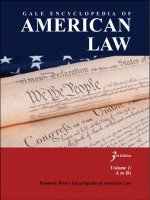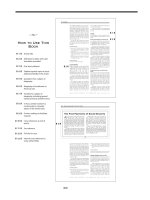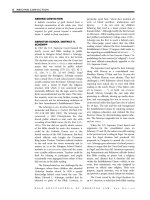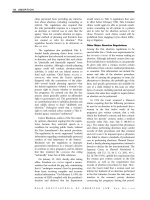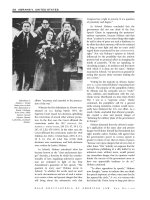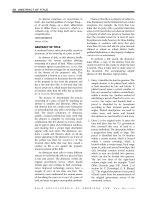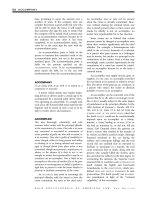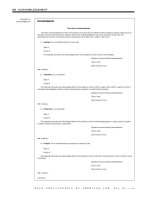Gale Encyclopedia Of American Law 3Rd Edition Volume 1 P35 pdf
Bạn đang xem bản rút gọn của tài liệu. Xem và tải ngay bản đầy đủ của tài liệu tại đây (392.88 KB, 10 trang )
makes a limited appearance and wins the case
can be sued again by the sam e plaintiff in a
different court.
In states that have no provision for a limited
appearance, a defendant can avoid being subject
to the personal jurisdiction of the court by
refusing to appear, thereby causing a default and
a consequent
FORFEITURE of the property. Or the
defendant can submit to the court’s personal
jurisdiction, defend the case on its merits, and
face the possibility of full liability. The defen-
dant must decide which course of action is best,
after comparing the value of the seized property
with the damages being sought by the plaintiff
and considering the likelihood of winning the
case at trial.
The Federal Rules of Civil Procedure do not
provide for limited appearances in federal court
but instead defer to state law on that issue. A
slightly greater number of courts permit limited
appearances than do not. The law of the
jurisdiction in which the action is brought must
be consulted to determine whether limited
appearances are permitted.
Withdrawal
If an appearance has been entered through
FRAUD or mistake or after the plaintiff’s com-
plaint has been materially amended, the discre-
tion of the court may permit the appearance to
be withdrawn. A proper withdrawal is treated as
if no appearance at all had been entered in the
case. A defendant who has withdrawn a general
appearance may ask the court for leave to file a
special appearance to challenge the court’s
jurisdiction.
If someone makes an unauthorized appear-
ance on behalf of the defendant, it may be
stricken or set aside by a motion of any party
with an interest in the proceeding.
Delay or Failure to Appear
A defendant who fails to appear in court
pursuant to a service of process might have a
default judgment entered against her or him
and be held in contempt of court. A failure to
appear does not, however, result in a
WAIVER of
objections to the court’s jurisdiction.
If a defendant fails to make an appearance
in the time allotted by statute or court rules,
he or she may lose certain righ ts. But if the
circumstances warrant it, a court may extend
the time of appearance.
FURTHER READINGS
McKinney, William Mark, and Burdett Alberto Rich. 1914.
Ruling Case Law. Northport, NY: Edward Thompson.
Weinreb, Lloyd L. 2006. Criminal Process: Cases, Comments,
Questions. 7th ed. Eagan, MN: Foundation.
Yeazell, Stephen C. 1998. Federal Rules of Civil Procedures:
With Selected Statutes and Cases. Frederick, MD: Aspen.
CROSS REFERENCE
Civil Procedure.
APPELLANT
A person who, dissatisfied with the judgment
rendered in a lawsuit decided in a lower court or
the findings from a proceeding before an adminis-
trative agency, asks a superior court to review the
decision.
An appellant, sometimes called the peti-
tioner, must demonstrate sufficient grounds for
appeal, which are usually specified by statute, in
order to challenge the judgment or findings.
Whether a party was a
PLAINTIFF or DEFENDANT in
the lower court has no bearing on his or her
status as an appellant.
APPELLATE
Relating to appeals, which are reviews by superior
courts of decisions made by inferior courts or
administrative agencies.
APPELLATE ADVOCACY
Appellate advocacy is the legal repr esentation by
an attorney before any state or federal court of
intermediate or final appeal.
The
U.S. COURTS OF APPEALS were created by
the Evarts Act of 1891 (28 U.S.C.A. § 43) and
are divided into 13 judicial circuits (see the
accompanying table). The central location of
each court is determined by statute (28 U.S.C.A.
§41[1995]). In addition, a court may sit any
place within its circuit and is required by statute
to sit in certain locations other than its central
location (28 U.S.C.A. § 44 [1995]). Appeals are
heard and decided by panels of three judges that
are selected randomly, by the
CIRCUIT COURT EN
BANC
(in its entirety), or by a division established
to perform the court’sen
BANC function in
larger circuits.
The circuit courts’
ORIGINAL JURISDICTION
included all matters not exclusively reserved
for the district trial courts. The circuit courts
also had appellate jurisdiction to review distri ct
GALE ENCYCLOPEDIA OF AMERICAN LAW, 3RD E DITION
328 APPELLANT
trial court decisions in civil cases in which the
AMOUNT IN CONTROVERSY exceeded $50 and in
admiralty cases in which the amount in
controversy exceeded $300. They have jurisdic-
tion to review final decisions of the federal
district trial courts, both civil and criminal.
Their jurisdiction extends only to matters
authorized by Congress. An appellate court
has no discretion in deciding whether to
consider the merits of an appeal over which it
has no jurisdiction. The most common basis for
appellate jurisdiction is an appeal from a final
district court judgment ( 324 U .S. 229, 2 8 U.S.C.A.
§1291[1995]). When a judgment is entered
that “ends the
LITIGATION on the merits and
leaves nothing f or the court to do but e xecute
the j udgment,” a case is completed ( Catl in v.
United States, 65 S. Ct. 631 [1945]).
Congress has progressively limited the
Supreme Court’s power to directly review trial
court decisions without a hearing in the courts
of appeals . Because Supreme Court review is
usually discretionary in the overwhelming
majority of cases, a court of appeals is the
highest federal tribunal where a litigant or
DEFENDANT can receive a hearing on the merits.
The Appeals Process
An unsuccessful party in a lawsuit or adminis-
trative proceeding may file a timely appeal to
an appropriate
SUPERIOR court empowered to
review a
FINAL DECISION, on the ground that it
was based upon an erroneous application of
law. The person who initiates the appeal, called
the appellant, must file a notice of appeal, along
with other necessary documents, to commence
appellate review. The person against whom the
appeal is brought, the appellee, then files a brief
in response to the appellant’s allegations.
Usually, review in the federal and state
courts goes through two stages: an appeal from
a trial court to an intermediate appellate court
and then to the highest appellate court in the
jurisdiction. An appeal may be granted as a
matter of right or as a matter of
CERTIORARI (at
the discretion of a superior appellate court). For
example, a party may appeal from a federal
district trial court to a U.S. court of appeals as a
matter of right, but may appeal to the U.S.
Supreme Court only by a grant of certiorari. An
appellate court may hear an appeal only if the
decision presented meets the statutory require-
ments for review.
The right to appeal is limited to the parties
to the proceedings who are aggrieved by the
decision because it has a direct and adverse
effect upon them or their property. Also, an
actual
CASE OR CONTROVERSY must exist at the
time of review. Issues that have become
MOOT
while the appeal is pending and cases that have
been settled are not reviewable.
For a case to be appealable, a final judgment
or order must have been reached by a trial
court. A judgment is considered final for
purposes of appeal when the action is ended
in the court where it was brought and nothing
more is to be decided.
An appeal must be made within the time
prescribed by statute or by the rules governing
the appellate court. The time for filing an appeal
begins to run once a final decision has been
made by the trial court. The appellant must file
a notice of appeal with the clerk of the appellate
court in order to begin the appeal and send a
copy to the appellee. If the appeal process is not
begun within the time set by statute, any right to
appeal is lost. If
EXTENUATING CIRCUMSTANCES
exist, an extension of time for filing the appeal
may be granted.
The appellate court can review only the trial
court record and the briefs filed by the appellant
and appellee. If permitted by the appellate
court,
AMICUS CURIAE briefs may also become part
of the record on appeal. (Amicus curiae means
“friend of the court.” A person who is not a
party to the action may petition the court for
permission to file such a brief.) The briefs must
contain the facts of the case, the grounds for
review, and arguments relating to the issues
raised.
The appellant’s brief must specifically dis-
cuss the alleged errors that entitle the appellant
to a reversal of the trial court’s decision and
discuss why each ruling was wrong, citing
authority such as a case or statute that applies
to the particular point at issue. The appellee
may file a brief containing arguments against
reversal and explaining why the trial court’s
ruling was correct. Only conclusions of law, not
findings of fact, made by a lower court are
reviewable. Appellate courts can decide only
issues actually before them on appeal.
The appellate court must decide whether the
errors alleged to have been made by the trial
court are harmless or prejudicial. If an error
substantially injures the rights of the appellant,
GALE ENCYCLOPEDIA OF AMERICAN LAW, 3RD E DITION
APPELLATE ADVOCACY 329
it is called a prejudicial error, or reversible error,
and warrants the reversal of the final judgment
or order. If the appeals court determines that
the error is technical or minimally affects the
rights of the parties or the outcome of the
lawsuit, it is considered a
HARMLESS ERROR and
insufficient to require a reversal or modification
of the decision of the trial court.
The appellate court may hear oral argu-
ments from each side. These arguments, which
usually last 10 to 15 minutes for each side, are
intended to help the court understand the issues
and to persuade the court to rule in favor of the
arguing party. During the arguments, the
appellate judge or judges may interrupt with
questions on particular issues or points of law.
After reviewing the appeal, the appellate
court may affirm the decision of the lower
court, modify it, reverse it, or remand the case
for a new trial in the lower court. When a
decision is affirmed, the appellate court accepts
the decision of the lower court and rejects the
appellant’s contention that the decision was
erroneous. When the appellate court modifies
the lower court’s decision, it accepts part of the
trial court’s decision and determines that
the appellant was partly correct in saying that
the decision was erroneous. The trial court’s
decision is then modified accordingly. In
reversing a decision, the appellate court indicates
that it agrees with the appellant that the lower
court’s decision was erroneous. The party who
lost the case at the trial court level then becomes
the winning party in appellate court. Occasion-
ally, a decision will be reversed, but the lawsuit
is still unresolved. In such cases, the appellate
court orders that the case be remanded
(returned) to the lower court for the determi-
nation of issues that remain unresolved.
Federal Criminal Appellate Advocacy
The SIXTH AMENDMENT to the U.S. Constitution
guarantees acriminal defendant the right to a jury
trial and the right to an attorney. The
FOURTEENTH
AMENDMENT
says states must provide criminal
defendants with these same guarantees. The U.S.
Supreme Court has repeatedly held that a person
found guilty in a criminal proceeding has no
constitutional right to appeal. A federal criminal
defendant’s right to appeal, therefore, is based on
an act of Congress.
Prior to 1776 and the founding of the
United States, many colonial legislatures
allowed, by special act, new trials of criminal
defendants. But generally, criminal appeals did
not exist when the U.S. Constitution was
drafted, and the
JUDICIARY ACT OF 1789 (ch. 20,
1 Stat. 73) did not provide for appellate review
of criminal cases. Thus, history does not
support a constitutional right to criminal
appeal. The issue was left to Congress.
Between 1855 and 1860 Congress refused to
provide for federal criminal appellate jurisdic-
tion, although several bills were introduced.
Finally in 1879, Congress authorized the federal
circuit courts to issue writs of error in criminal
cases on a discretionary basis. In 1889 Congress
gave defendants sentenced to death the right of
direct appeal to the U.S. Supreme Court. In
1891 it extended the Supreme Court’s jurisdic-
tion for review to al l “cases of conviction of a
capital or otherwise infamous crime ” (26 Stat.
827, quoted in 775 S. Ct. 1332 [1957]). Because
of the burden on the Supreme Court of hearing
a large number of criminal appeals, in 1897
Congress transferred jurisdiction over noncapi-
tal appeals to the circuit courts of appeals. In
1911 Congress abolished the right of direct
appeal to the Supreme Court in capital cases,
and the circuit courts became the appellate
courts for all criminal cases.
In 1894, in McKane v. Durston (153 U.S. 684,
14 S. Ct. 913, 38 L. Ed. 867), a unanimous
Supreme Court determined that no matter
how serious the offense, a criminal defendant
had no constitutional right to appea l her or his
conviction.
The Criminal Justice Act (18 U.S.C.A. §
3006A [1995]) is an outgrowth of the Sixth
Amendment
RIGHT TO COUNSEL. The act requires
courts to develop and implement plans to
furnish representation for defendants charged
with felonies or misdemeanors, other than petty
offenses, who are financially unable to obtain an
attorney. Although the act is directed primarily
to proceedings at the trial court level, it provides
that any person for whom counsel is appointed
shall be represented at every stage of the
criminal proceedings, from the defendant’s
initial appearance through the appeal process.
State Criminal Appellate Advocacy
All U.S. states provide defendants some form of
appeal from a criminal conviction. Appeals were
well-established elements of state crimin al
proceedings throughout the nineteenth century.
GALE ENCYCLOPEDIA OF AMERICAN LAW, 3RD E DITION
330 APPELLATE ADVOCACY
They probably developed earlier in state court
systems because state governments had primary
responsibility for enforcing criminal laws from
the founding of the nation through the 1800s,
since very few federal statutory offenses existed
during this period.
Because states decided that criminal appeals
were necessary to protect the innocent, the
Supreme Court determined that appellate
procedures must comply with the federal
constitutional guarantees of due process and
EQUAL PROTECTION (Griffin v. Illinois, 351 U.S. 12,
76 S. Ct. 585, 100 L. Ed. 891 [1956]). In Douglas
v. California (372 U.S. 353, 83 S. Ct. 814, 9 L.
Ed. 2d 811 [1963]), the Supreme Court held that
a state violates a defendant’s constitutional
protections when it forces an indigent, who
has a statutory right to appeal, to attempt the
appeal without the assistance of an attorney.
The Supreme Court reasoned that without an
attorney, an appeal constituted nothing more
than a “meaningless ritual.” Therefore, a state
must provide counsel to a defendant who wants
to exercise the right to appeal but cannot afford
to hire a lawyer.
In 2009 the Supreme Court faced a novel
question regarding the reaches of appointed
appellate counsel in Harbison v. Bell (No. 07-
8521, 556 U.S. ___ [2009]). The question before
the Court was whether Harbison, a death-row
inmate who had exhausted all his state court
and federal habeas appeals, could request a
federally appointed (and funded) attorney (who
had represented him in filing the federal
WRIT of
HABEAS CORPUS) to represent him (if no other
attorney was available) to prepare a last-ditch
petition for state
CLEMENCY proceedings. The
Court, by a 7–2 decision, said yes.
Tennessee law no longer authorized the
appointment of state public defenders for
clemency proceedings. Therefore, Harbison’s
federally appointed habeas attorney had
requested the district court to expand the scope
of her representation to include the state
clemency proceedings, relying on 18 USC
§3599 (which provides for the appointment of
federal counsel) for authority. Section §3599 (a)
2 expressly refers to the federal habeas statute
sections §2254 and §2255, providing for the
appointment of counsel in “both state and
federal post-conviction proceedings.” Section
§3599 (e) in relevant part, states that counsel is
available to any defendant sentenced to death in
“proceedings for executive or other clemency as
may be available to the defendant.” Despite the
language, there had been a split in the federal
circuit courts as to whether Section §3599
provided for federally funded attorney only in
executive clemency proceedings from the presi-
dent or also clemency from state governors or
pardon boards. The Supreme Court found that
both were covered under Section §3599.
Ineffective Appellate Representation
In 1985 the Supreme Court held that a
defendant has the right to the effective assis-
tance of appellate counsel. The Court concluded
that a defendant whose counsel does not
provide effective representation is “in no better
position than one who has no counsel at all ”
(Evitts v. Lucey, 469 U.S. 387, 105 S. Ct. 830, 83
L. Ed. 2d 821 [1985]). However, in Ro ss v.
Moffitt (417 U.S. 600, 94 S. Ct. 2437, 41 L. Ed.
2d 341 [1974]), the Supre me Court held that a
criminal defendant does not have a constitu-
tional right to appointed counsel on a discre-
tionary review.
In Roe v. Flores-Ortega (528 U.S. 470, 120
S. Ct. 1029, 145 L. Ed. 2d 985 [2000]), the Court
considered whether a defense lawyer must
always consult with a de fendant regarding an
appeal of the conviction. In this case, the
defendant (Flores-Ortega) alleged ineffective
counsel because his attorney did not file an
appeal within the 60-day time period dictated
by the jud ge in his original case. The Court
rejected a bright-line rule (a strict rule with no
ability to use discretion) that would have
mandated such a consultation, ruling that each
case must be analyzed using a set of standards.
The Court in Roe held that a defendant
claiming ineffective assistance of counsel must
show that the attorney’s representation “fell
below an objective standard of reasonableness”
and that the attorney’s deficient performance
prejudiced the defendant. The Court used a test
set out in Strickland v. Washington (466 U.S.
668, 104 S. Ct. 205, 80 L. Ed. 2d 674 [1984])to
determine if Flores-Ortega’s attorney was con-
stitutionally ineffective for failing to file a notice
of appeal. It directed that an inquir y should
begin by asking whether the attorney in fact
consulted with the defendant about the appeal.
Such a consultation meant advising the defen-
dant on the pros and cons of taking an appeal
and making a reasonable effort to discover the
defendant’s wishes. However, the defendant
GALE ENCYCLOPEDIA OF AMERICAN LAW, 3RD E DITION
APPELLATE ADVOCACY 331
would still have to show that there was a
reasonable probability that, but for his attor-
ney’s conduct, he would have filed a timely
appeal.
In Glover v. United States (531 U.S. 198, 121
S. Ct. 696, 148 L. Ed. 2d 604 [2001]), the
Supreme Court ruled that defendants are
entitled to a hearing to prove that they received
ineffective counsel on an appeal. In this case,
the defendant argued that his appellate attorney
failed to appeal his sentence, which he claimed
had been miscalculated under federal
SENTENC-
ING
guidelines. This failure would mean serving
between six and 21 months longer in prison. An
appeals court held that theincrease inhis sentence
was not serious enough to merit a review of his
ineffective counsel claim. The Supreme Court
disagreed, ruling that any amount of jail time
justified a hearing into the issue.
The Supreme Court considered another
claim of ineffective appellate counsel in Mickens
v. Taylor (535 U.S. 162, 122 S. Ct. 1237, 152 L.
Ed. 2d 291 [2002]), but this one involved trial
counsel. However, the rule announced in
Mickens could be made applicable to claims of
ineffective appellate counsel. The defendant had
been convicted of
MURDER and sentenced to death.
During the course of his death penalty appeals,
his appellate attorney discovered that the defen-
dant’s trial attorney had represented the murder
victim shortly before his murder. This was not
disclosed to the defendant during his trial. The
defendant argued that this tainted his trial, as
there was no way the defense attorney could have
been objective.
The Supreme Court disagreed, in a decision
that signaled a departure from its death penalty
jurisprudence. Because of the finality of a death
sentence, the Court previously required less
hard evidence of prejudice from in effective
counsel. In Mickens, the Court stated that the
general rule for ineffective counsel should also
be applied to capital murder cases. Under this
standard the defendant must show that “but
for” the lawyer’s conduct, the result of the trial
would have been different. The Court will
presume an adverse effect “where assistance of
counsel has been denied entirely or during a
critical stage of the proce eding.” In Mickens,
however, the Court found that the trial attorney
had done an acceptable job in representing the
defendant, so no adverse effect could be
presumed. Because the defendant could not
show that the outcome of his trial would have
been any different but for the actions of his
attorney, his appeal was rejected (see also
Schriro v. Landrigan aka Hill No. 05-1575, 550
U.S.___ [2007]).
FURTHER READINGS
Arkin, Marc M. 1992. “Rethinking the Constitutional Right
to a Criminal Appeal.” University of California at Los
Angeles Law Review 39.
———. 1990. “Speedy Criminal Appeal: A Right without a
Remedy.” Minnesota Law Review 74.
Beazley, Mary Beth. 2002. A Practical Guide to Appellate
Advocacy. New York: Aspen.
Berry, Carole C. 2009. Effective Appellate Advocacy: Brief
Writing and Oral Argument. 4th ed. St. Paul, Minn.:
West Group.
Frederick, David C. 2002. Supreme Court and Appellate
Advocacy. St. Paul, Minn.: West Group.
Junkin, Federick D.1988. “The Right to Counsel in ‘Frivolous’
Criminal Appeals: A Reevaluation of the Guarantees of
Anders v. California.” Texas Law Review 67.
Klonoff, Robert H. and Gregory Castanias. 2008. Federal
Appellate Practice and Procedure in a Nutshell. St. Paul,
Minn.: Thomson/West.
Knibb, David G. 1990. Federal Court of Appeals Manual. 2d
ed. St. Paul, Minn.: West.
National Conference of Bar Examiners (NCBE), 2009. “2008
Statistics.” The Bar Examiner, May 2009. Text available
online at />downloads/Bar_Admissions/2008_Stats.pdf; website
home page: />stats/ (accessed August 5, 2009)
Rubin, Alvin B. 1989. Advocacy in the Court of Appeal.
American Law Institute-American Bar Association.
No. C380.
CROSS REFERENCES
Criminal Law; Federal Courts; Habeas Corpus; Supreme
Court of the United States.
APPELLATE COURT
An appellate court has jurisdiction to review
decisions of a trial-level or other lower court.
An unsuccessful part y in a lawsuit must file
an appeal with an appellate court in order to
have the decision reviewed. In the United States,
appellate courts exist at both the federal and the
state levels, and generally they consist of a panel
of two or more judges. On the federal level,
decisions of the U.S. district courts, where civil
and criminal matters are tried, can be appealed
to the U.S. court of appeals for the circuit
covering the district court. Eleven numbered
federal judicial circuits have been established.
Each circuit comprises a number of states that
are usually, though not always, in close
geographic proximity. For example, the Eighth
Circuit includes Arkansas, Iowa, Minnesota,
GALE ENCYCLOPEDIA OF AMERICAN LAW, 3RD E DITION
332 APPELLATE COURT
Missouri, Nebraska, and North and South
Dakota, and the Sixth Circuit is made up of
Kentucky, Michigan, Ohio, and Tennessee.
Washington, D.C., has two
U.S. COURTS OF
APPEALS
: the District of Columbia CIRCUIT COURT
of Appeals, which hears appeals arising out of
decisions of the Federal District Court for the
District of Columbia, and the U.S. Court of
Appeals for the Federal Circuit, which has
exclusive and nationwide jurisdiction in appeals
from U.S. district court decisions in patent,
copyright, trade mark, and other specialized
areas.
A decision of a U.S. court of appeals may be
appealed to yet ano ther appellate court, the
Supreme Court of the United States. An appeal
to the Supreme Court is made by filing a
petition for
CERTIORARI (a document requesting a
review of court records). The Supreme Court
has broad discretion in determining whether to
review decisions. The Court receives thousands
of petitions per year, but can only review about
one hundred cases in that span of time. It most
often denies certiorari and hears only cases that
raise important and unsettled constitutional
questions or in which the federal appellate
courts have reached conflicting decisions on the
same issue.
On the state level, a decision of a state trial
court—usually a district or other local court—
can be appealed to a state appellate court for
review. In most states, a case must first be
appealed to an intermediate appellate court. If it
receives an unfavorable ruling at the intermedi-
ate level, the case can then be appealed to the
highest appellate court in the state, usually the
state supreme court. Like the Supreme Court of
the United States, a state’s highest court usually
has the discretion to decide whether to review a
decision reached by the intermediate court.
Some cases decided by the highest court in a
state also can be appealed to the U.S. Supreme
The interior chambers
of the U.S. Supreme
Court, the last forum
for appeals of lower
court decisions.
AP IMAGES
GALE ENCYCLOPEDIA OF AMERICAN LAW, 3
RD E DITION
APPELLATE COURT 333
Court, though again the U.S. Supreme Court
will hear only appeals of major significance.
In both state and federal matters, in general,
an appeal can be brought only after a
FINAL
DECISION
, or final judgment, in the ACTION has
been entered. A judgment is final for the
purposes of an appeal when nothing more is
to be decided in the action, and it concludes all
rights that were subject to
LITIGATION. This rule
is based in part on the desire for judicial
economy: It is more efficient for all matters to
be heard in one appeal than for a case to be
conducted “piecemeal” (in several appeals)
before it is finally resolved. However, both state
and federal courts will in some instances hear an
INTERLOCUTORY appeal, which is an appeal of a
matter that does not decide the entire case but
must be addressed before the case can be
decided on its merits. In other instances,
whether an interlocutory appeal will be granted
depends on the issue at hand. If the issue
concerns whether the lawsuit shou ld go forward
at the trial level, it is more likely to be heard,
since it may avoid an unnecessary trial. For
example, an interlocutory appeal may be
permitted from an order granting or denying
an injunction, even though the main issues in
the case have yet to be tried.
The proceedings in the federal and state
appellate courts are quite different from those
that take place in a trial court. At the trial level,
WITNESSES are called to TESTIFY and a jury is often
present to hear evidence and reach a
VERDICT.At
the appellate level, the trial court record and
briefs prepared by both parties are revi ewed,
and oral arguments may be heard; witnesses are
not called and no jury is convened. The trial
court record usually contains the pleadings that
first initiated the case, a complete transcript of
the court proceedings, materials admitted into
evidence, and documents indicating the final
judgment.
An appellate court differs from a trial court
in another important respect: Only the trial
court determines the factual issues in a case. In
its review, the appellate court does not try
factual issues. Instead, it determines only
whether there is sufficient evidence to support
the findings of the trial court and whether the
trial court correctly applied the law.
Both the appellant (the party appealing the
lower-court ruling) and the appellee (the party
against whom the appeal has been brought) file
written briefs with the appellate court. The
briefs—which recite the facts of the case,
the arguments being raised on appeal, and the
applicable law—help the court decide whether
the trial court erred in its decision.
The appellate court may also hear oral
arguments in the case. During oral argument,
each party has 10 to 15 minutes to persuade the
appellate court to rule in its favor. If numerous
issues have been raised, a party may choose to
use most of this time to cover the issues that are
most crucial to the decision to be made. The
court is free to interrupt an oral argument with
questions concerning the facts of the case or the
particular areas of law involved. The appellate
court, at its discretion, may determine that oral
argument is not necessary and may decide the
case based only on the trial court record and the
written briefs.
In making its decision, the appellate court
may affirm the trial court, mea ning that it
accepts the decision of the lower court, or may
reverse it, thus agreeing with the appellant’s
contention that the trial court’s decis ion was
erroneous. It may also modify the decision; in
this instance, the court may accept part of the
trial court’s decision while ruling that other
issues were erroneously decided.
The appellate court usually issues its deci-
sion in the form of a written opinion stating its
reasons for the decision. The opinion will
discuss the relevant facts and apply the law to
those facts. Appellate court opinions are usually
published, thus forming a body of law, known
as precedent, that attorneys and judges can
consult for guidance in resolving similar legal
questions.
FURTHER READINGS
Cohen, Jonathan Matthew. 2002. Inside Appellate Courts:
The Impact of Court Organization on Judicial Decision
Making in the United States Courts of Appeals. Ann
Arbor: Univ. of Michigan Press.
Klein, David E. 2002. Making Law in the United States Courts
of Appeals. New York: Cambridge Univ. Press.
Klonoff, Robert H. 2008. Federal Appellate Practice and
Procedure in a Nutshell. 1st ed. Thomson West.
Smithburn, J. Eric. 2009. Appellate Review of Trial Court
Decisions. Durham, N.C.: Carolina Academic Press.
Sunstein, Cass R., David Schadke, Lisa M. Ellman, and
Andres Sawicki. 2006. Are Judges Political? Washington,
D.C.: Brookings Institution Press.
Wisotsky, Steven. 2009. Professional Judgment on Appeal:
Bringing and Opposing Appeals. Durham, N.C.: Carolina
Academic Press.
GALE ENCYCLOPEDIA OF AMERICAN LAW, 3RD E DITION
334 APPELLATE COURT
CROSS REFERENCES
Appeal; Appellate Advocacy; Courts; Federal Courts.
APPELLEE
A party who has won a judgment in a lawsuit or
favorable findings in an administrative proceed-
ing, which judgment or findings the losing party,
the appellant, seeks to have a higher court reverse
or set aside.
The designation as appellee is not related to
a person’s status as
PLAINTIFF or DEFENDANT in the
lower court.
Another name for appellee is respondent.
CROSS REFERENCE
Appeal.
v
APPLETON, JOHN
JOHN APPLETON was a prominent nineteenth-
century Maine lawyer and judge. He served as a
justice and chief justice of the Maine Supreme
Judicial Court from 1852 to 1883. During his
long tenure he came to be recognized for his
opposition to state laws that granted loans or
tax exemptions to businesses. His belief in free
market capitalism translated into minim al
government regulation of business and no
government breaks for business. In addition
Appleton concerned hims elf with rethinking
COMMON LAW rules of evidence.
Appleton was born on July 12, 1804, in New
Ipswich, New Hampshire. He graduated from
Bowdoin College—where his uncle, Jesse
Appleton, was president—in 1822 and then
apprenticed himself to a New Hampshire lawyer
to gain the knowledge needed to become a
member of the bar. Appleton was admitted to
the bar in 1826 and moved to Sebec, Maine, to
start a private practice. Maine had been
admitted to the Union in 1820 and was a
growing, prosperous state. Appleton moved
again to Bangor in 1838 and continued his
PRIVATE LAW practice. A great reader of philoso-
phy and law, Appleton was attracted to the
utilitarian philosophy of
JEREMY BENTHAM.An
interest in the law from a purely intellectual
viewpoint led him to pursue a judgeship.
In 1841 he was appointed the reporter of
decisions for the Maine Supreme Judicial Court,
the state’s highest court. In this capacity
Appleton edited the opinions of the justices,
which gave him valuable insights into the
workings of an appellate court. His diligence
and intellectual esteem led to his appointment
as a justice of the court in 1852. Eleven years
later he was elevated to chief justice, a position
he held for the next 31 years. Apart from his
judicial opinions, Appleton published in 1860 a
treatise entitled The Rules of Evidence, Stated and
Discussed.
Appleton’s opinions from the early 1870s on
the proper relationship between government
and business have come to be regarded as
groundbreaking expressions of laissez-faire
constitutionalism. After the Civil War state
governments had rushed to give railroads and
other businesses tax exemptions, loans, and
property easements. When the town of Jay
sought legislative authority to loan $10,000 to
private entrepreneurs to move their mill and
factory to the town, the legislature sought an
ADVISORY OPINION from Maine’s supreme court.
In a bluntly worded opinion, Appleton declared
that the legislature had no authority to help
private businesses through gifts or loans. When
John Appleton 1804–1891
❖
❖
◆
◆
◆◆◆
1804 Born,
New Ipswich, N.H.
◆
▼▼
▼▼
18501850
18751875
19001900
18001800
18251825
◆
◆
◆
◆
◆
◆
◆
◆
◆
1822 Graduated
from Bowdoin College
1826 Admitted to bar
and moved to Maine
1841 Appointed reporter of decisions,
Maine Supreme Judicial Court
1852 Appointed
associate justice,
Maine Supreme
Judicial Court
1863 Appointed chief
justice, Maine Supreme
Judicial Court
1883 Retired
from Supreme
Judicial Court
1891 Died,
Bangor, Maine
1860 Rules of Evidence
treatise Published
1820 Missouri Compromise
enacted, limiting slavery
1854 Kansas-Nebraska
Act passed
1861–65
U.S. Civil War
1857 Supreme Court issues Dred Scott
decision; Missouri Compromise unconstitutional
1877
Reconstruction ends
1865 Thirteenth Amendment
abolished slavery
1883 U.S. Supreme Court strikes down
Civil Rights Act of 1875
1882 Congress enacts
Chinese Exclusion Act
GALE ENCYCLOPEDIA OF AMERICAN LAW, 3RD E DITION
APPLETON, JOHN 335
the legislature ignored this opinion and autho-
rized the funding, Appleton issued an opinion
ruling the act unconstitutional. Appleton’s
analysis foreshadowed the
SUBSTANTIVE DUE
PROCESS
doctrine that the U.S. Supreme Court
employed to strike down government regula-
tions of business.
Appleton finally retired in 1883. He died on
February 7, 1891, in Bangor, Maine.
FURTHER READINGS
Gold, David M. 1990. The Shaping of Nineteenth-Century
Law: John Appleton and Responsible Individualism.
Westport, Conn.: Greenwood.
———. 2000. “The Tradition of Substantive Judicial
Review: A Case Study of Continuity in Constitutional
Jurisprudence.” Maine Law Review, 52.
Karsten, Peter. 1997. “Supervising the ‘Spoiled Children of
Legislation’: Judicial Judgments Involving Quasi-Public
Corporations in the Nineteenth-Century United
States.” American Journal of Legal History, 41.
Witt, John Fabian. 1999. “Making the Fifth: The Constitu-
tionalization of American Self-Incrimination Doctrine.”
Texas Law Review, 77.
APPOINT
To designate, select, or assign authority to a
position or an office.
Although sometimes used interchangeably,
elect and appoint do not have the same meaning.
Election refers to the selection of a public officer
by the qualified voters of the community, and
appointment refers to the selection of a public
officer by one authorized by law to do so.
APPOINTMENT, POWER OF
A power that is conferred upon a donee to dispose
of the donor’s proper ty by nominating and
selecting one or more third-parties to receive it.
The property may consist of tangible items such as
cars, boats, and household items, or it may consist
of an intangible interest in property, such as the
right to receive dividend income from stocks.
A
POWER OF APPOINTMENT may be transferred
only in writing, such as by deed, trust, or will.
Donees who receive an oral promise to be given
a power of appointment, however, may bring an
action for
PROMISSORY ESTOPPEL if they have relied
to their detriment on that promise. In no case
will a court find that a power of appointment
had been created unless the donor’s intent to
create the power is demonstrated; the person
who would hol d the power is indicated; the
circumstances under which the power could be
exercised are identified; and the property that is
subject to the power is specified.
No particular semantic formula is necessary
for the creation of a power of appointment. Any
written expression, however informal, will
suffice so long as it clearly indicates an intention
to create such a power. Thus, a power of
appointment may be created by implication.
For example, a devise or bequest of property to
a person as he or she may designate to receive it
or subsequently transfer it gives that person a
power of appointment. A
TESTAMENTARY gift to a
donee for life, to be at his or her disposal, or
with a right to dispose of it at the donor’s death,
concers a power of appointment. For example,
if a donor gives the donee an automobile to use
as the donee sees fit during the donee’s lifetime,
the donor has given the donee a power of
appointment over the automobile. Similarly, if a
donor gives the donee authority to dispose of
the automobile upon the donor’s death, the
donor has given the donee a power of appoint-
ment over the automobile.
There are three classes of powers of appoint-
ment. General powers of appointment give
donees the power to dispose of the property in
any way they see fit. Limited powers of appoint-
ment, also known as special powe rs of appoin t-
ment, give donees the power to transfer the
property to a specified class of persons identified
in the instrument creating the power. Testamen-
tary powers of appointment are powers of
appointment that typically are created by wills.
APPORTIONMENT
Apportionment is the process by which legislative
seats are distributed among units entitled to
representation; determina tion of the number of
representatives that a state, county, or other
subdivision may send to a legislative body. The
U.S. Constitution provides for a census every ten
years, on the basis of which Congress apportions
representatives according to population; each state,
however, must have at least one representative.
Districting is the establishment of the precise
geographical boundaries of each such unit or
constituency. Apportionment by state statute that
denies the rule of one-person, one-vote violates the
equal protection of laws.
Apportionment is also the allocation of a charge or
cost such as real estate taxes between two parties,
often in the same ratio as the respective times that
the partie s are in possession or ownership of
GALE ENCYCLOPEDIA OF AMERICAN LAW, 3RD E DITION
336 APPOINT
property during the fiscal period for which the
charge is made or assessed.
JAMES MADISON and his fellow founders of the
United States of America had many objectives as
they framed the U.S. Constitution. One was
equal representation in a governme nt run by
members of Congress on behalf of citizens of
the United States. To ensure that equal
representation occurred, the founders proposed
that the U.S. population be counted at regular
intervals with a census. They later agreed in the
Great Compromise of 1787 that congressional
representation should be assigned—in other
words, apportioned—to various regions of the
country based on a total population standard.
Both Article 1, Section 2, Clause 3, and
Amendment 14, Section 2, of the Constitution
provide that representatives shall be appor-
tioned among the states according to their
respective numbers and that a population count
will be taken by census every ten years.
Apportionment requires that each state’s total
population be divided by the population of “the
ideal district” to determine the appropriate
number of representatives. The population of
an ideal district, for purposes of federal
apportionment, is defined as the total popula-
tion of the state (as determined by census)
divided by one hundred (for the House of
Representatives), or by 50 (for the Senate).
In the centuries that followed the adoption
of the U.S. Constitution, apportionment for the
federal Cong ress has been based on total
population—with the exception that a slave,
until the Civil War, was considered property
and thus counted only as three-fifths of a white
person. Efforts to limit federal congressional
apportionment to only people who are citizens
U.S. House of Representatives Membership in 2009
1–3
4–9
10–19
20 or more
Number of representatives per state
2
Hawaii
1
A
la
ska
SOURCE: U.S. House of Representatives Web site, “Congressional Apportionment,” available online at />house_histor
y
/con
g
A
pp
/b
y
state.html (accessed Au
g
ust 6, 2009).
1
Montana
9
Washington
5
Oregon
53
California
3
Nevada
2
Idaho
1
Wyoming
3
Utah
7
Colorado
3
New Mexico
8
Arizona
1
North Dakota
8
Minnesota
1
South Dakota
3
Nebraska
4
Kansas
5
Oklahoma
32
Texas
8
Wisconsin
5
Iowa
9
Missouri
4
Arkansas
7
Louisiana
19
Illinois
15
Michigan
9
Indiana
18
Ohio
19
Pennsylvania
29
New York
3
W.Va.
11
Virginia
13
N.Carolina
6
Kentucky
9
Tennessee
4
Miss.
7
Alabama
13
Georgia
6
S.Carolina
25
Fla.
2
Maine
1
Vt.
2
N.H.
10 Mass.
2 R.I.
5 Conn.
13 N.J.
1 Del.
8 Md.
1 D.C.
ILLUSTRATION BY GGS
CREATIVE RESOURCES.
REPRODUCED BY
PERMISSION OF GALE,
A PART OF CENGAGE
LEARNING.
GALE ENCYCLOPEDIA OF AMERICAN LAW, 3
RD E DITION
APPORTIONMENT 337

